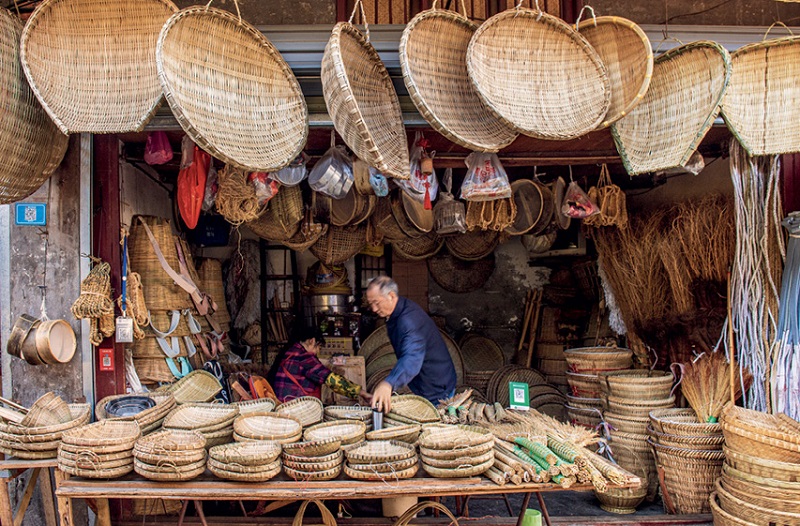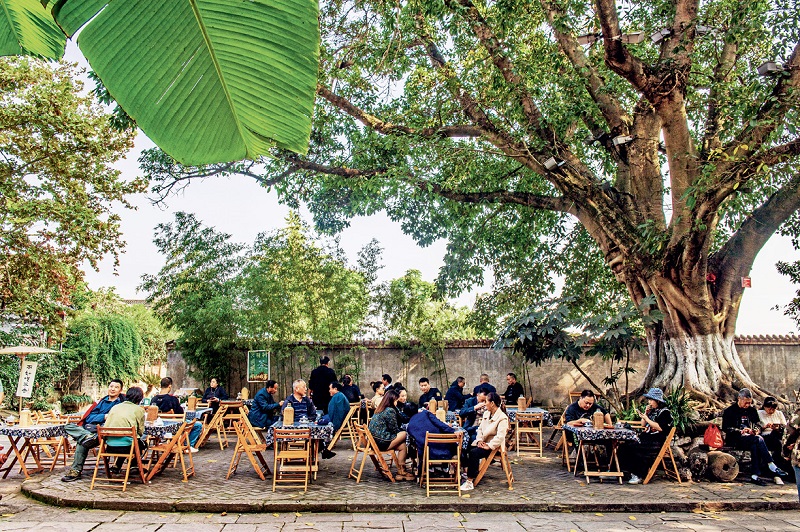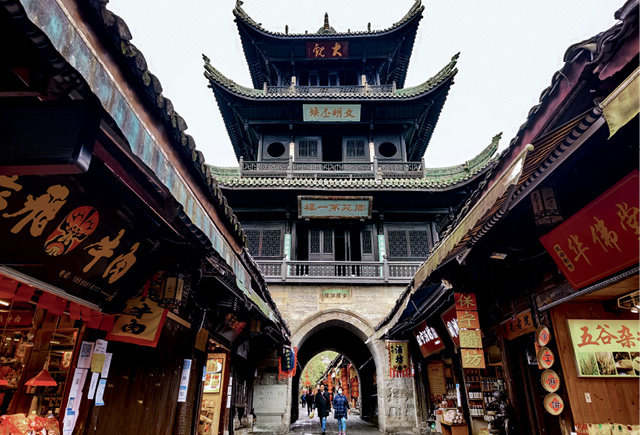This well-preserved historic city in Sichuan Province can trace its origins back to a bygone age, boasting a diverse culture and impressive legacies spanning multiple fields.

Folk artists are celebrating the Chinese New Year in Langzhong by putting on a cultural performance on the street, on January 18, 2024.
The old city of Langzhong is located in Nanchong City of southwest China’s Sichuan Province. It is considered to be among the best known ancient cities in China and its history can be traced back 2,300 years. Langzhong used to be the capital of the ancient Shu State during the Warring States Period (475-221 BC), later becoming the seat of local governments through different dynasties and the provincial capital for 20 years during the late Ming (1368-1644) and early Qing (1644-1911) dynasties.
Even today, the layout it had during the Tang Dynasty (618-907) remains preserved, as well as the architectural features of the Ming and Qing dynasties. Covering an area of approximately two square kilometers, this old city is characterized by more than 100 ancient dwellings dating to the Ming and Qing dynasties, 90 historic streets and alleys, as well as over 1,000 old residential complexes. It is also known for hosting a variety of cultures including those of the Three Kingdoms, the imperial civil examinations, and the Spring Festival. With 31 historic sites under state or provincial protection, this city is rated as one of the most preserved ancient cities in China, and also designated as a National 5A Tourist Attraction.
Historic Towers
The Chinese people have a tradition of respecting and admiring nature since antiquity. In constructing cities and houses, great priority and importance is ascribed to building in such a manner so as to utilize natural landscapes and achieve harmonious coexistence between humans and nature. The old city of Langzhong is a fine example of this design philosophy, with water flowing on three sides while being nestled among the surrounding mountains. The imposing Panlong Mountain in the north block the strong southward wind and the Jialing River gently wraps around the city like a silky ribbon.
The city was laid out in a grid with the Zhongtian Tower in the center. The tower was built in the Tang Dynasty and was renovated in 2006. This quaint three-story erection stands 20.5 meters tall, blending well into the surrounding complexes. The tower can be seen from anywhere in the city. Its top floor affords a picturesque panoramic vista of the city, the mountains, and the Jialing River.
The Guanghua Tower is among the most magnificent towers among the existing old towers in Langzhong. It was built on the site of a building that was constructed by the famous Tang Dynasty prince Li Yuanying. In the Qing Dynasty, it burnt down in a blaze and was rebuilt years later.
Standing in the south of the city, the tower also functions as a gate facing a port by the Jialing River. This wooden structure is 36 meters high and is supported by four wooden poles from the ground to the ceiling. Each window is carved with exquisite patterns. Its three-layered three-meter roof is elaborately decorated with an array of figures and sculptures of fantastical mystic creatures. Visitors can enjoy the view of the city on the balcony on each floor.
Today, except for historic buildings, some old residential complexes going back to the Ming and Qing dynasties are open to the public, allowing visitors to have an up-close look at these old dwellings.

Two shopkeepers looking after a bamboo weaving store in the old city of Langzhong on January 18, 2024.
Shrine of Lord Heng
Located at the intersection of the Jianmen Mountain, Daba Mountain, and Jialing River — which serve as natural fortifications — Langzhong was a major city of military significance in history. Zhang Fei, a highly celebrated general during the Three Kingdoms Period (220-280), was assigned to govern this city for seven years. He was not only adept at leading troops on the battlefield, but also noted for his exceptional governing ability. After Zhang assumed the position in Langzhong, he launched several projects to reinforce city walls and other defensive facilities in and around the city. His plan of building irrigation canals to divert water from the Jialing River to irrigate crops led to remarkable agricultural progress in Langzhong. Seeing Langzhong’s favorable climatic conditions, he also encouraged local people to plant white mulberry trees and cultivate silkworms. Through his efforts, Langzhong became a thriving economic hub in the north of Sichuan. After Zhang Fei died, Langzhong people constructed a shrine around his grave, marking his great contribution to their city’s prosperity. His legacy lasted long after the Three Kingdom Period, during which the city did not see any warfare and its residents led peaceful lives.
The temple in honor of Zhang Fei is called Han Lord Heng’s Shrine. Lord Heng was a title bestowed upon him by the emperor of the Shu Kingdom (who was a descendant of the ruling family of the Han Dynasty) after the general’s death — a tradition for prominent figures in ancient China. This historic structure dating back 1,700 years is now under state protection. Situated in the west of the city, it was a grand courtyard complex covering an area of 20,000 square meters and composed of a main hall, a back hall, a tomb pavilion, the tomb, and other buildings. It houses a collection of stone inscriptions and plaques as well as over 1,000 cultural relics, providing a glimpse of Langzhong’s rich cultural legacy over the past 2,300 years. This temple was refurbished during the Ming and Qing dynasties but still retains its original layout and design.

People enjoy their leisure time at an outdoor teahouse in the old city of Langzhong on January 18, 2024.
Qing Dynasty Sichuan Examination Hall
During the Qing Dynasty, Langzhong was the interim provincial capital of Sichuan for 17 years. During that period, the central government established an examination hall in Langzhong as the venue for conducting provincial imperial civil examinations, which was part of the rigorous process to elect officials in feudal China. In addition to the fact that Langzhong hosted this major examination, it also enjoyed the reputation of highly valuing education — evidenced by four zhuangyuans originating from Langzhong. Zhuangyuan was the person who achieved the highest score in the national imperial civil examination.
This examination hall is well-preserved despite the passage of over three centuries, making it one of the best-preserved Qing Dynasty provincial examination halls in China. Today, this historic complex is listed as a key cultural relic site under state protection. It contains exam rooms, archive rooms, supervisor rooms, transcribing rooms, and multiple halls commemorating different zhuangyuans and well-known scholars, as well as displaying historical exam-bribery cases and anti-cheating policies.
Spring Festival Old Man
The Spring Festival Old Man is the centerpiece of the Spring Festival celebration events in Langzhong every year. Donning a red festive costume, the jovial old man gives away red envelopes bearing good wishes to children on streets. This custom is attributed to a real person, Luoxia Hong.
Luoxia Hong (156-87 BC), born and raised in Langzhong during the Western Han Dynasty, was a prominent calendrical astronomer. He had a genuine interest in astronomy since childhood. In recording the length of the shadow of a bamboo pole every day, he discovered that its length varied not only in different times in a day, but also in different seasons of the year. Through consistent effort, he discovered the relation between the changes of 24 solar terms and Twenty-Eight Mansions (which can be considered a Chinese version of the zodiacal constellations in Western astronomy).
He was called to the imperial capital by Emperor Wudi to compile a new calendar called “Tai Chu Calendar.” It is considered as the first complete Chinese calendar, and the first official calendar incorporating 24 solar terms, helping guide agricultural activities in appropriate terms. He assigned the “zheng month” on the Chinese lunisolar calendar as the first month of the year, and the first day of the zheng month as the first day of the year. Since then, the exact date of Spring Festival was confirmed. After the calendar was completed, Emperor Wudi offered Luoxia Hong an official position, but Luoxia declined and returned to Langzhong. Luoxia Hong later resumed his astronomical studies, improved the armillary sphere, advanced the armillary principle, and educated other people about astronomy. By virtue of his influence and the astronomical legacy bequeathed by him, generations of astronomers emerged in Langzhong throughout dynasties.
As ancient China prioritized literary culture over technology, official documents at that time did not include any biographies of Luoxia Hong. However, his name and accomplishments have never been forgotten. In September 2004, the Working Group for Small Bodies Nomenclature of International Astronomical Union named the “16757” asteroid after Luoxia Hong. A museum dedicated to him was also built in his beloved hometown Langzhong, displaying his inspiring life story and legacy linked to the study and development of astronomy.

Pedestrians are walking through an archway in the city wall under a tower of the old city of Langzhong on March 21, 2022.
Traditions Live On
As a city closely connected to the Spring Festival culture, Langzhong hosts a variety of celebrations during the Spring Festival season every year. With an effort focusing on utilization and protection of its rich culture, combining inheritance and innovation, and presenting folk customs, Spring Festival events have become the signature events of the city.
To preserve the landscapes of the old city, pass down traditional culture, and enhance the tourist experience, an industrial tourism park was constructed in Qili New Area adjacent to the old city. This zone provides a range of tours to experience historical culture, modern industry, educational tourism, and other cultural activities. In this park, tourists are able to take an inside look of traditional workshops to see how the local specialties such as Zhang Fei beef and Langzhou vinegar are made by hand, and also sample the authentic tastes of these foods. There are also Three-Kingdoms-themed hotels and a food court offering various traditional Sichuan dishes.
Its picturesque scenery, well-preserved historic buildings, rich culture of the Three Kingdoms, examination hall, and astronomic legacy, as well as the increasing tourist-friendly amenities attract visitors in droves to savor the charms of this old city.